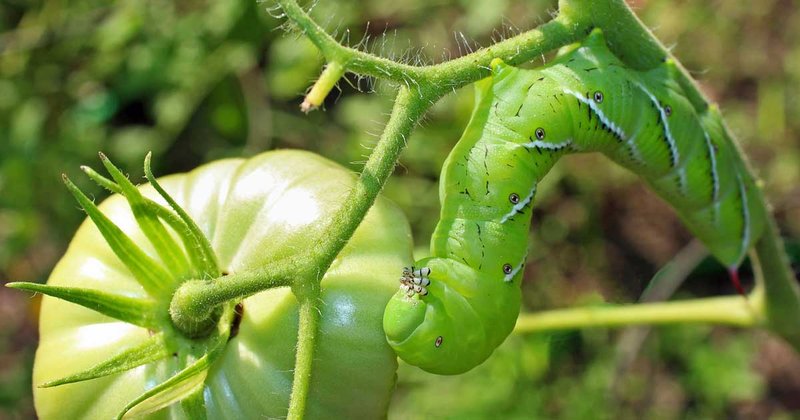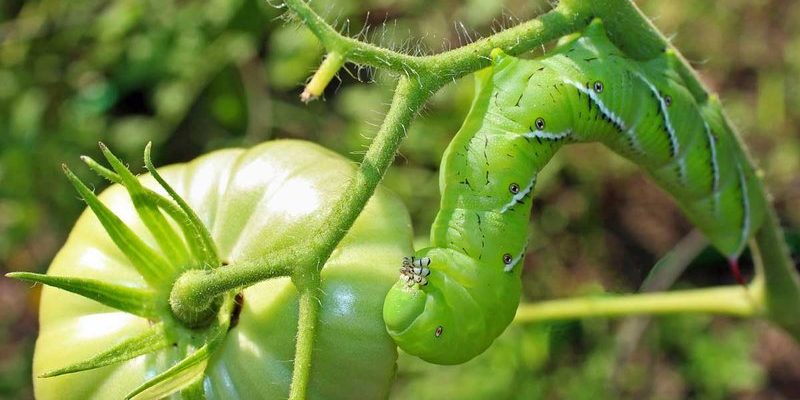
Tomato hornworms are the larval stage of the five-spotted hawk moth. They can quickly turn from harmless caterpillars to ruthless garden munchers. So, picture this: you’ve put in all that effort to nurture your plants, only to have a tiny monster doing a number on them! These worms can be hard to spot because they blend in so well with the foliage. But don’t worry, identifying them isn’t as tricky as finding a needle in a haystack—once you know what to look for.
What Do Tomato Hornworms Look Like?
When it comes to identifying tomato hornworms, the first thing you’ll notice is their size. These caterpillars can grow up to 4 inches long! Imagine something nearly as long as a hot dog just hanging out on your tomato plant. They’re typically a vibrant green color, which helps them blend in with the leaves.
A key feature you won’t want to miss is the horn-like projection on their rear end, which is where they get their name. Some people compare it to a tiny unicorn horn—if it were green, and on a caterpillar, that is! This horn is not just for show; it’s a defense mechanism against predators.
Another thing to keep in mind is that these worms can have white stripes running along their sides. These stripes help break up their shape, making them harder to spot. Honestly, you might find yourself staring right at one without realizing it!
Where Do Tomato Hornworms Come From?
Understanding where these pests come from can help you better prepare your garden. Tomato hornworms are the larval stage of the five-spotted hawk moth, which lays its eggs on the leaves of tomato and other related plants.
You might be wondering when these little critters make their debut. Typically, the moths emerge in late spring or early summer, especially if the weather is warm and humid. After laying eggs, it only takes a few days for those eggs to hatch into tiny hornworms. It’s like a fast-food chain for them; once they’re out, they’re ready to eat!
Another interesting tidbit: hornworms prefer not just tomatoes but also other nightshades like peppers and eggplants. So, if you’re growing those in your garden, keep an eye on them as well!
Signs of Tomato Hornworm Damage
One of the easiest ways to identify tomato hornworms in your garden is by looking for signs of damage. If your tomato leaves are suddenly missing chunks or are totally devoured, that’s a red flag.
Another thing to watch for is *frass*, which is just a fancy word for caterpillar poop. You’ll likely find small, dark pellets on the leaves and the soil beneath your plants. It’s a pretty clear indication that hornworms are hard at work!
Lastly, if you notice your plants wilting or looking unhealthy, that could be due to their voracious appetite. These hornworms can defoliate a plant in no time, leaving you with sad-looking tomato plants instead of the lush green you were hoping for!
How to Find Tomato Hornworms in Your Garden
Now that you know what to look for, how do you actually find these sneaky pests? The best time to look for them is during the daytime, as they’re most active in the evening. Here’s a little step-by-step on finding them:
1. Check Leaves: Start by inspecting the leaves of your plants, especially the undersides. Hornworms love to hide there.
2. Look for Damage: If you see any chewed leaves, focus your search there. They’re likely nearby!
3. Use Your Senses: Listen for the sounds of chomping or rustling. It may sound silly, but sometimes you can hear them munching away.
4. Shake the Plant: If you’re still not sure, gently shake the branches. Hornworms may drop off and you’ll catch them in the act!
By actively searching your garden every few days, you’ll be able to catch these pests early before they do too much damage. Think of it as your garden’s regular health check-up!
Getting Rid of Tomato Hornworms
If you do find tomato hornworms, don’t panic! There are several ways to eliminate them without turning to harsh chemicals. Here are some options:
- Handpicking: You can simply pick them off by hand. If you’re squeamish, wear gloves or use a stick. Drop them into a bucket of soapy water to get rid of them for good.
- Neem Oil: Spraying neem oil on your plants can deter hornworms and other pests. Just mix it with water according to package instructions and spray in the evenings when the sun isn’t too harsh.
- Beneficial Insects: Encouraging natural predators like parasitic wasps can also help control hornworm populations. They lay their eggs inside the hornworms, eventually killing them.
- Row Covers: Using row covers can prevent moths from laying eggs on your plants, cutting off the hornworm life cycle at the source.
Each of these methods has its pros and cons, so you might want to try a combination to see what works best for your garden.
Preventing Tomato Hornworms
Prevention is key when it comes to keeping tomato hornworms at bay. Here are some tried-and-true methods to protect your plants:
1. Plant Diversity: Mix in other plants with your tomatoes. This distracts pests and makes it harder for them to find their favorite snack.
2. Maintain Garden Hygiene: Keep your garden clean by removing dead plants and debris. Hornworms can hide in these spots, so a tidy garden is less inviting.
3. Crop Rotation: Avoid planting tomatoes or other nightshades in the same spot every year. Rotating your crops disrupts pest life cycles.
4. Companion Planting: Some plants, like marigolds, can deter pests naturally. Adding these to your garden can create a friendlier environment for your tomatoes.
By setting up these preventive measures, you can create a healthier ecosystem in your garden, making it less attractive to hornworms and other pests.
Identifying and dealing with tomato hornworms may seem daunting at first, but it’s totally manageable with the right knowledge. Now you have the tools to spot these pesky pests before they wreak havoc on your garden. Keeping a close eye on your plants, understanding their habits, and knowing how to act quickly can save your precious tomatoes!
Remember, gardening is a journey full of learning and maybe a few hiccups along the way. With these steps, you’ll be well on your way to protecting your vegetable garden and enjoying the fruits of your labor—literally! Happy gardening!

